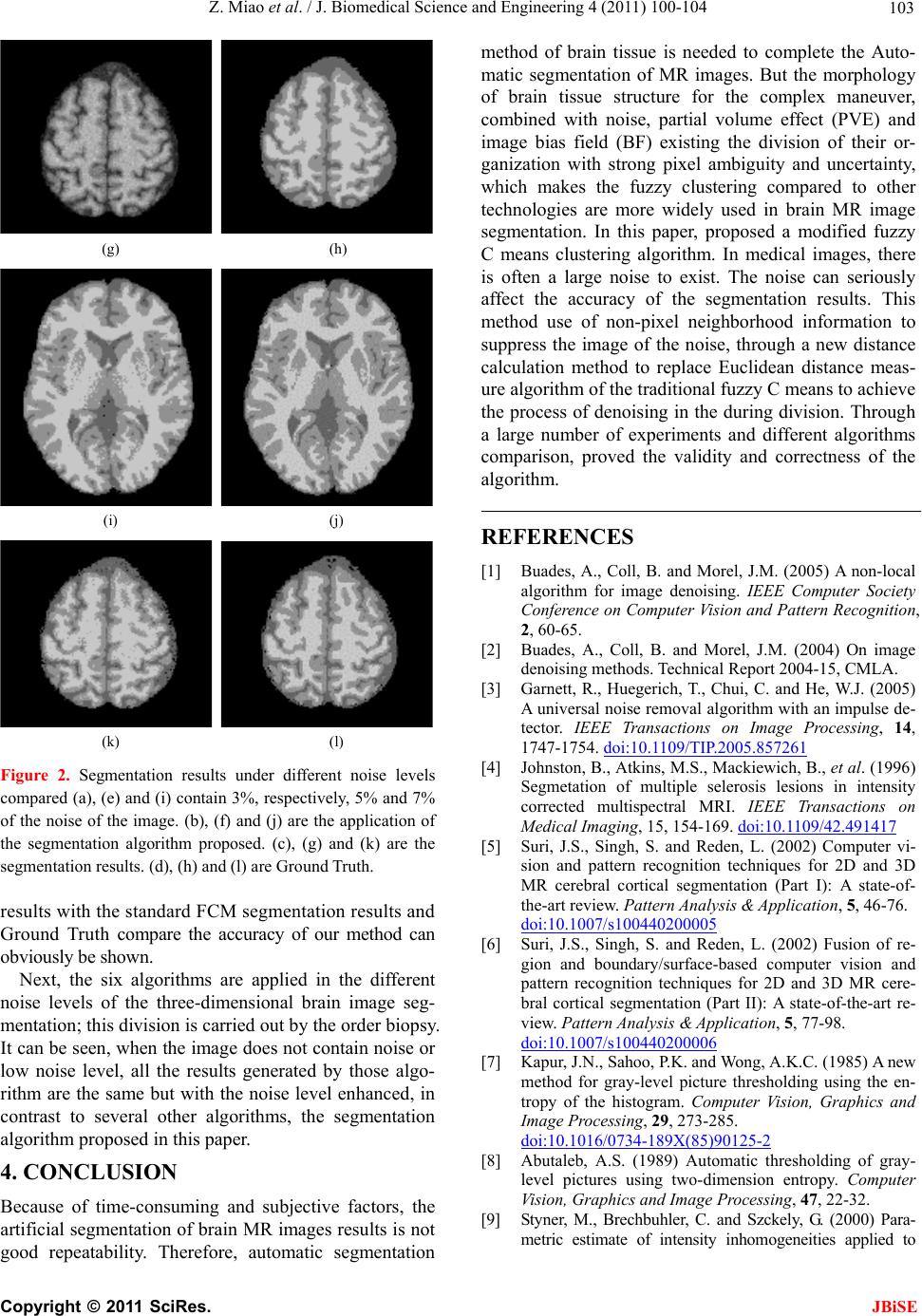
Z. Miao et al. / J. Biomedical Science and Engineering 4 (2011) 100-104 103
(g) (h)
(i) (j)
(k) (l)
under differe
sults with the standard FCM segmentation results and
rithms are applied in the differe
no
ing and subjective factors, the
good repeatability. Therefore, automatic segmentation
NCES
B. and Morel, J.M. (2005) A non-local
ge denoising. IEEE Computer Society
Figure 2. Segmentation resultsnt noise levels
compared (a), (e) and (i) contain 3%, respectively, 5% and 7%
of the noise of the image. (b), (f) and (j) are the application of
the segmentation algorithm proposed. (c), (g) and (k) are the
segmentation results. (d), (h) and (l) are Ground Truth.
re
Ground Truth compare the accuracy of our method can
obviously be shown.
Next, the six algont
ise levels of the three-dimensional brain image seg-
mentation; this division is carried out by the order biopsy.
It can be seen, when the image does not contain noise or
low noise level, all the results generated by those algo-
rithm are the same but with the noise level enhanced, in
contrast to several other algorithms, the segmentation
algorithm proposed in this paper.
4. CONCLUSION
Because of time-consum
artificial segmentation of brain MR images results is not
method of brain tissue is needed to complete the Auto-
matic segmentation of MR images. But the morphology
of brain tissue structure for the complex maneuver,
combined with noise, partial volume effect (PVE) and
image bias field (BF) existing the division of their or-
ganization with strong pixel ambiguity and uncertainty,
which makes the fuzzy clustering compared to other
technologies are more widely used in brain MR image
segmentation. In this paper, proposed a modified fuzzy
C means clustering algorithm. In medical images, there
is often a large noise to exist. The noise can seriously
affect the accuracy of the segmentation results. This
method use of non-pixel neighborhood information to
suppress the image of the noise, through a new distance
calculation method to replace Euclidean distance meas-
ure algorithm of the traditional fuzzy C means to achieve
the process of denoising in the during division. Through
a large number of experiments and different algorithms
comparison, proved the validity and correctness of the
algorithm.
REFERE
[1] Buades, A., Coll,
algorithm for ima
Conference on Computer Vision and Pattern Recognition,
2, 60-65.
[2] Buades, A., Coll, B. and Morel, J.M. (2004) On image
denoising methods. Technical Report 2004-15, CMLA.
[3] Garnett, R., Huegerich, T., Chui, C. and He, W.J. (2005)
A universal noise removal algorithm with an impulse de-
tector. IEEE Transactions on Image Processing, 14,
1747-1754. doi:10.1109/TIP.2005.857261
[4] Johnston, B., Atkins, M.S., Mackiewich, B., et al. (1996)
Segmetation of multiple selerosis lesions in intensity
corrected multispectral MRI. IEEE Transactions on
Medical Imaging, 15, 154-169. doi:10.1109/42.491417
[5] Suri, J.S., Singh, S. and Reden, L. (2002) Computer vi-
sion and pattern recognition techniques for 2D and 3D
MR cerebral cortical segmentation (Part I): A state-of-
the-art review. Pattern Ana lysis & Application , 5, 46-76.
doi:10.1007/s100440200005
[6] Suri, J.S., Singh, S. and Reden, L. (2002) Fusion of re-
gion and boundary/surface-based computer vision and
pattern recognition techniques for 2D and 3D MR cere-
bral cortical segmentation (Part II): A state-of-the-art re-
view. Pattern An aly sis & A pplicat ion, 5, 77-98.
doi:10.1007/s100440200006
[7] Kapur, J.N., Sahoo, P.K. and Wong, A.K.C. (1985) A new
method for gray-level picture thresholding using
the en-
tropy of the histogram. Computer Vision, Graphics and
Image Processing, 29, 273-285.
doi:10.1016/0734-189X(85)90125-2
[8] Abutaleb, A.S. (1989) Automatic thresholding of gray-
level pictures using two-dimension entropy. Computer
Vision, Graphics and Image Processing, 47, 22-32.
[9] Styner, M., Brechbuhler, C. and Szckely, G. (2000) Para-
metric estimate of intensity inhomogeneities applied to
C
opyright © 2011 SciRes. JBiSE